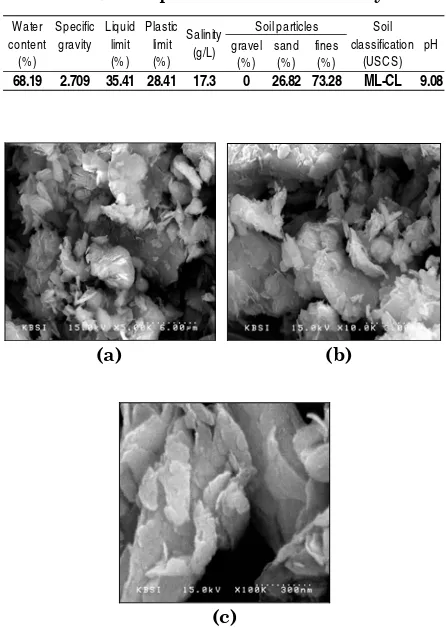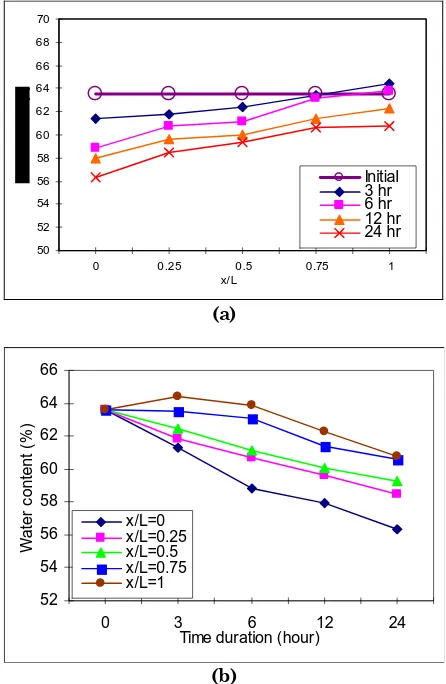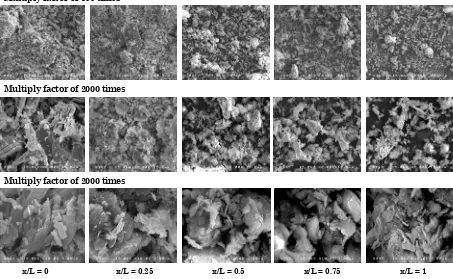IMPROVING MARINE CLAYS WITH ELECTROKINETICS
METHOD
Daniel Tjandra, Paravita Sri Wulandari
Lecturer, Civil Engineering Department, Faculty of Civil Engineering and Planning, Petra Christian University, Surabaya,Indonesia
Email: [email protected]; [email protected]
ABSTRACT
The high water content in marine clays could loosen the bond of soil particles, resulting in low bearing capacity and high compressibility of the soil. Excessive settlements could happened to the structures built on it. An electrokinetic process was attempted to reduce the high water content of the marine clay. An experimental study was conducted to evaluate the effect of electrokinetic on marine clay improvement. This study focused on the use of electrokinetic to enhance the soil bearing capacity of marine clay by improving index properties of the marine clay. The result of this research was obtained by doing several analyses on water content, pH value, and soil particles of soil sample located between cathode and anode. Based on the results from laboratory testing, it can be concluded that electrokinetic process decreased the water content and pH value of soil surrounding the anode. Also, soil particles surrounding the anode became in close proximity. This indicated that as it became closer to the anode, soil became denser.
Keywords: electrokinetics, water content, pH value
INTRODUCTION
Marine clays are often characterized by low shear strength and high compressibility. High water content on the marine clay will caused the marine clay to loose the bond of soil particles and its bearing capacity will decreased. Thus, excessive settlement would happen to the structures built on it. The alternative solutions for this condition are enlarging dimension of its foundation or applying soil impro-vement.
Recently, there are many significant developments in soil improvement method as the solutions for problems on soft soil of new or existing construction [1]. One of those soft soil improvement methods is the application of electrokinetic to strengthen soft soil bearing capacity [2].
This paper presents results of electrokinetic labora-tory experiments without seepage. The goal of the present research is to investigate physical and chemical properties of the marine clay including water content, pH value, and particle structures due to the electrokinetic process.
Note: Discussion is expected before November, 1st 2007, and will be published in the “Civil Engineering Dimension” volume 10, number 1, March 2008.
Received 4 Augst 2006; revised 2 April 2007, 16 May 2007; accepted 25 June 2007.
ELECTROKINETIC THEORY
In geotechnical engineering, there are many resear-ches of application of electric current to clays in strengthening the soil [2]. This method has an advantage such as application on low permeability soil, fine grained soil, and high pore water soil. Electrokinetic is a soil improvement methods by supplying electric current to electrodes which are embedded in the soil. According to Shang and Materson [3], the improvement of soil characteristics is shown by the increase in shear strength about 69%, shear modulus about 151%, and pre-consolidation pressure about 700%. In the next research [4], with the rearrangement of electrodes placement, the foundation bearing capacity incre-ased as great as four times and undrained shear strength of the soil was improved about three times after being continually supplied by a DC current of 5.2 V in 14 days.
The applied electric current leads to electrolysis reactions in the electrodes. Oxidation of water at the anode generates an acid front while reduction at the cathode produces a base front by the following electrolysis reactions [2],
Anode : 2H2O – 4e− O2 + 4H+ (1)
Cathode: 2H2O + 2e− H2 + 2OH− (2)
The electrolysis reactions are then followed by H+
strengthen the soil bearing capacity in the vicinity of the anode.
Several factors are influencing the electrokinetic process as shown in Table 1.
Table 1. The influencing factors in electrokinetic process [5]
Factors Characteristics
Size of soil particle and type of mineral
Effective on particle size less than 2 m is as 30% or more
More effective on silty clays with moderate plasticity (kaolinite dan illite) rather than high plasticity clays
Salinity Not effective on soil with high salinity Soil
condition
pH
Not effective on soil with low pH value (pH < 6)
Effective on soil with high pH value (pH > 9) Current density Variation depends on geotechnical characteristic
of soil
Electrodes
Use of metal from silver, platinum, iron, and copper are more effective rather than aluminum, black carbon, and lead
System
Configuration of
electrodes Depend on the site condition (pore water flow)
CHARACTERISTICS OF SOIL SAMPLE
In this research, application of electrokinetic method is conducted to marine clay with index properties as stated in Table 2. The initial structure of soil particle is represented by SEM (Scanning Electron Micros-cope) test as shown in Figure 1.
Table 2. Index Properties of The Marine Clay
Soil particles
Figure 1. SEM with The Multiply Factor (a) 5000 times, (b) 10000 times, (c) 100000 times
RESEARCH METHODOLOGY AND
EXPERIMENTAL PROCEDURE
This research is conducted by supplying a current of 20 volt in the anode and cathodes with duration of three, six, 12, and 24 hours. The anode was a cylinder pile made from stainless steel and the cathodes were made from copper. A schematic experimental setup of the electrokinetic process is presented below (Figure 2). Soil samples were taken at the location (*) of x/L = 0 (anode), x/L = 0.25, x/L = 0.50, x/L = 0.75, and x/L = 1 (cathode) as shown at Figure 2b.
(a)
(b)
Figure 2. Model (a) and Configuration (b) of The Electrodes in The Soil Sample
This research is conducted by the laboratory testing procedure as follows. Soil is placed in an open 50cm cube Plexiglas box, hand compacted to a volume of 50 x 50 x 40 cm3. Afterwards the copper pipe as the
(a)
(b)
Figure 3. The Experimental Equipment
RESULT AND DISCUSSION
The result of this research is obtained by doing several analyses on water content and pH value of soil sample located between the electrodes. An analysis on soil particle structures (SEM test) after electrokinetic process was also conducted to investigate the effects of electrokinetic on the soil improvement.
Water Content
The water content, before and after electrokinetic process, is presented in Figure 4. Before the electrokinetic process, the water content at various distances between anode and cathode had the same value. After the electrokinetic process, water moved from anode to cathode, thus the water content at the cathode area (x/L = 1) was higher than at the anode area (x/L = 0) as shown in Figure 4(a).
Besides, the water content was decreasing with the increase of time (Figure 4b). The decreased water content naturally strengthened the soil.
50
Figure 4. The water content variation on the location of anode (a) and the time duration (b)
pH
Figure 5 shows the variation in pH value before and after electrokinetic process. As the water moved from the anode to the cathode, pH value at the anode became lower than before the electrokinetic process. On the other hand, pH value at the cathode became higher than before the electrokinetic process.
(a)
0 2 4 6 8 10 12 14
0 3 6 12 24
Time duration (hour)
pH
x/L=0 x/L=0.25 x/L=0.5 x/L=0.75 x/L=1
(b)
Figure 5. The pH Value Variation on Location of Anode (a) and Time Duration (b)
Scanning Electron Microscope (SEM)
SEM test was conducted on the soil sample located between the anode and the cathode (x/L = 0; 0.25; 0.5; 0.75; 1) to depict soil particle after the electro-kinetic process. The soil particles surrounding the anode (x/L = 0) are in close proximity compare to the soil particles surrounding the cathode (x/L = 1). Thus, soil surrounding the anode became denser after the electrokinetic process. This condition is related to the water movement from the anode to the cathode.
CONCLUSIONS
The following is a summary of the conclusion from this experimental study:
1. Electrokinetic process decreased the water con-tent of soil surrounding the anode up to 13%. 2. From the result of SEM test after the
electro-kinetic process, soil particles surrounding the anode became in close proximity. This indicates that closer to the anode, soil become denser. 3. After electrokinetic process, pH value at the
anode decreased up to 257% and at the cathode increased up to 33%. This should be considered in the application of the electrokinetic method, because acid condition surrounding the anode could cause corrosion on the metal of the anode. 4. An interesting phenomena happened at location
x/L = 0.67, where pH value was not dependent with the time duration. At x/L < 0.67, pH value decreased as the increase in time duration, and at the location x/L > 0.67, pH value increased as the increase in time duration.
0 2 4 6 8 10 12 14
0 0.25 0.5 0.75 1
x/L
pH
0 hr 3 hr 6 hr 12 hr 24 hr x/L=0.67
Multiply factor of 500 times
Multiply factor of 2000 times
Multiply factor of 2000 times
x/L = 1 x/L = 0.25
REFERENCES
1. D.T. Bergado, L.R. Anderson, N. Miura, and A.S. Balasubramaniam, Soft Ground Improvement, American Society of Civil Engineers, New York,1996.
2. Tjandra, D and Wulandari, P.S., Pengaruh Elek-trokinetik Terhadap Daya Dukung Pondasi Tiang di Lempung Marina, Dimensi Teknik Sipil, Vol 8 no 1, March 2006, pp 15-19.
3. Shang, J.Q. and Masterson, K.L., An Electro-kinetic Testing Apparatus for Undisturb/ Remoulded Soils under In-Situ Stress Condition,
Geotechnical Testing Journal, GTJODJ, Vol. 23, No. 2, June 2000, pp. 221-230.
4. Misic, S., Shang, J.Q., and Lo, K.L., Load-carry-ing Capacity Enhancement of Skirted Foun-dation Element by Electrokinetics, International Journal of Offshore and Polar Engineering, Vol. 13, No. 3, September 2003.


